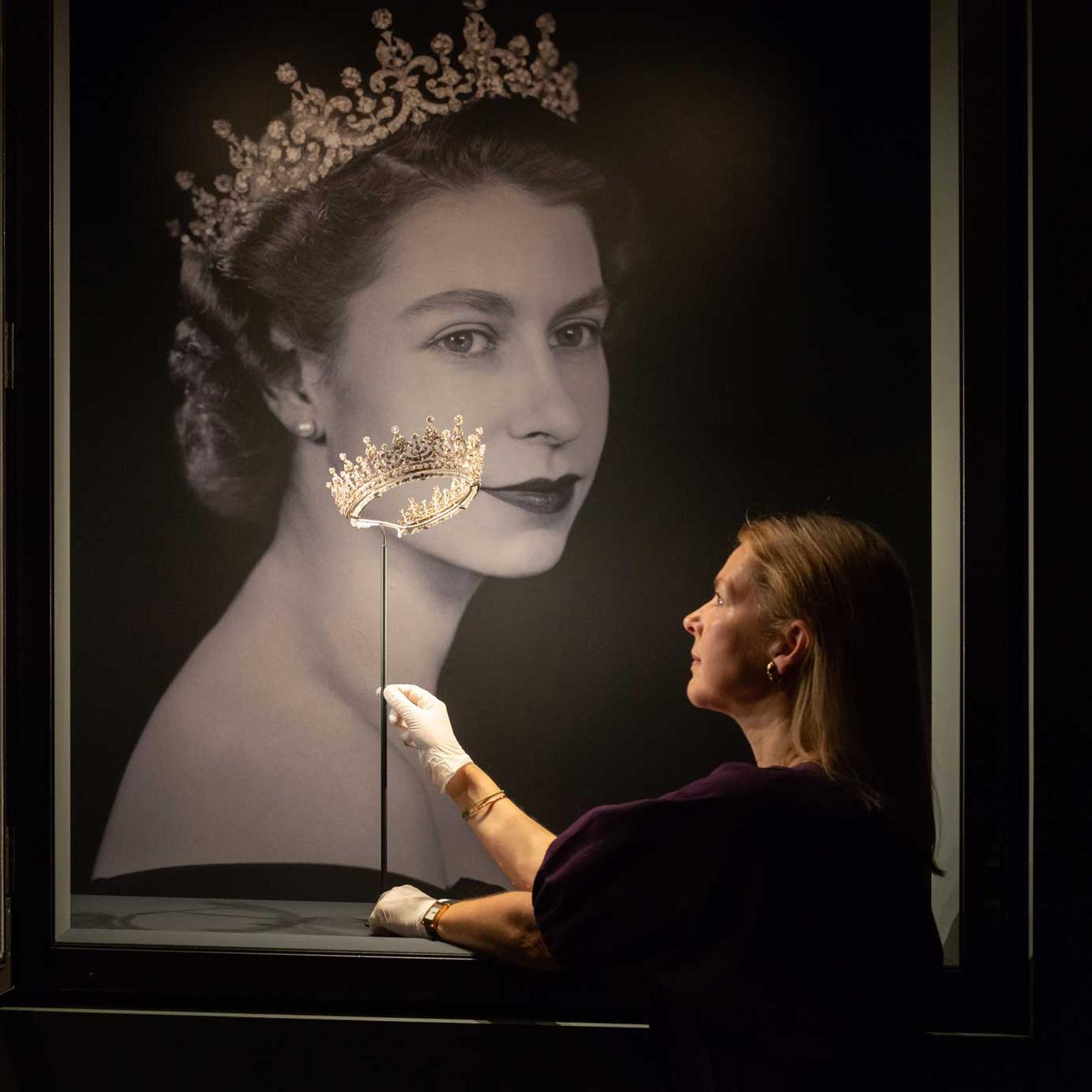
The doors of Buckingham Palace have finally reopened with a dazzling exhibition. As part of the Summer Opening of the State Rooms, jewellery lovers will be treated to a shimmering display of jewels from the The Queen’s personal collection, some exhibited for the first time ever.
Platinum Jubilee: The Queen’s Accession celebrates the early days of Her Majesty’s reign curated by Caroline de Guitaut Deputy Surveyor of The Queen’s Works of Art. The jewels, each with a special personal or historical significance, are shown alongside 24 official hand-finished photographic portraits by Dorothy Wilding of Her Majesty wearing the jewels on display (below). The photographer Wilding had worked with the Royal Family since the 1920’s and the portraits of the new Queen Elizabeth are particularly significant as they are the basis for the profile of Her Majesty on coins and stamps.

Unlike the Crown Jewels, that belong to the State, these treasures sit in Her Majesty’s own collection. The most recognisable jewel is certainly The Girls of Great Britain and Ireland Tiara (above), given to the future Queen Mary on her marriage to George VI in 1893. The money was raised by a committee headed by Lady Eva Greville, one of Queen Mary’s ladies-in-waiting who commissioned Garrard & Co to make the piece in 1893. The work was carried out by E.Wolff & Co. and the tiara was designed so that it could be taken off its frame and also worn as a necklace. The original version was tipped with pearls but Queen Mary replaced these with 13 large diamonds from the Surrey tiara. The pearls were then set into the Lover’s Knot tiara.
In turn, Queen Mary gave it to Princess Elizabeth for her wedding in 1947 along with the Dorset Bow brooch. Her Majesty has been seen on numerous occasions wearing this tiara including on coins and bank notes making this one of the most iconic jewels in her collection.
Read about The Queen's Diamond Jubilee Celebration exhibition from 2012 here.
Watch the 2012 video below:
Another head-turning jewel is the Diamond Diadem made by Rundell, Bridge & Rundell in 1820 that is set with 1,333 diamonds and a pale yellow diamond inside the front cross, all resting on a pearl and diamond bandeau. Commissioned by Queen Adelaide and associated with female royalty it was in fact made for George IV’s extravagant coronation, postponed for a year by the trial of Queen Caroline. His Majesty wore it at ceremonies leading up to the coronation though it was difficult to spot due to the large velvet ‘Spanish’ hat and ostrich plume that were included in the original design. The diadem includes the symbols of England, Scotland and Ireland in the form of delicate rose, thistle and shamrock all in the new transparent style of setting. As was the custom, the diamonds for the diadem were hired but in this case, the diamonds remained in the jewel. The Queen wore the diadem to the first State Opening of Parliament of her reign in 1952 –and to every one since - and perhaps most famously to Westminster Abbey for her coronation in 1953.
Another tiara on show is the Vladimir Tiara attributed to Bolin, St Petersburg circa 1874. It was made for the Grand Duchess Maria Pavlovna, who was the last Romanov to escape from Russia. The tiara was damaged as it was smuggled out of Russia to the UK and it was later sold by her daughter to Queen Mary in 1921 and inherited by The Queen in 1953. It has been extensively renovated, most recently by Garrard & Co in 1988. The tiara is unusual as the pendant emeralds can be removed or substituted for pearls.

In the final sitting of the Wilding portraits Her Majesty wears the Diamond Diadem and the impressive Delhi Durbar necklace (below). The necklace incorporates nine emeralds originally owned by Queen Mary’s grandmother, the Duchess of Cambridge, who won them in a German state lottery in Frankfurt in 1818. The necklace was the centrepiece of the jewels created for Queen Mary for the 1911 Delhi Durbar. As well as the nine magnificent emeralds, it also boasts an 8.8-carat diamond pendant cut from the Cullinan diamond, the largest diamond ever found. Her Majesty inherited the necklace in 1953. The accompanying emerald and diamond earrings will also be on display for the first time.

The Nizam of Hyderabad necklace was a wedding present from the Indian ruler or nizam. He most generously left instructions with Cartier London for Princess Elizabeth to select the gift herself. The platinum necklace is set with 300 diamonds and Her Majesty wore it for the second sitting with Wilding in 1952 that was used on postage stamps from 1953 to 1971.
Of less material value, but of symbolic interest is the gold coronet that was made for the 11-year old Princess Elizabeth for her parents’ coronation that she wore with a richly embroidered cream dress and a purple robe. Of personal interest is the sapphire and diamond Cartier bracelet given to her by her father for her 18th birthday. Other exhibits include the Queen Mary’s Bangles from the late 19th century as well as the South Africa necklace, given to Princess Elizabeth for her 21st birthday by the Government and Union of South Africa. The necklace originally consisted of 21 brilliant-cut diamonds, but in 1952 it was shortened and the six removed stones were made into a matching bracelet, which will also be on display.
The exhibition is open until 2 October. Click here for more visitor information and tickets.















